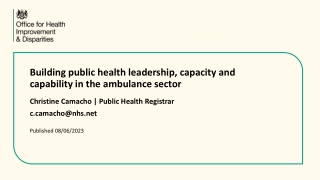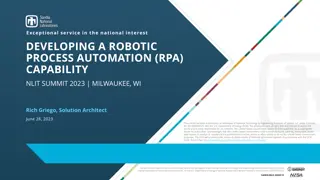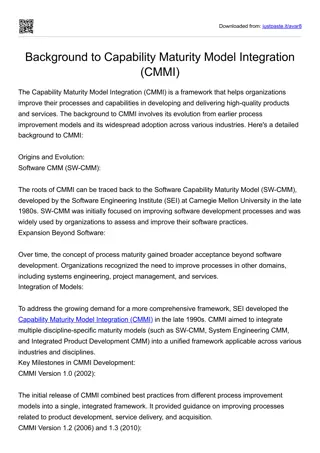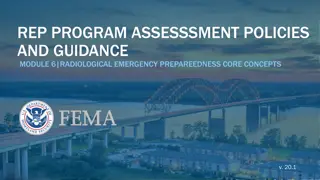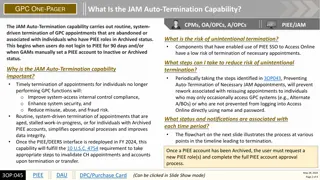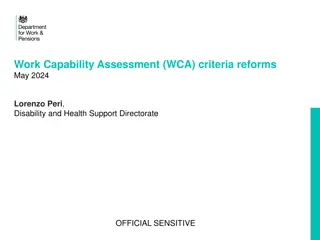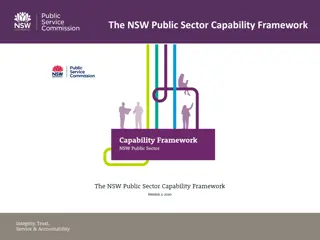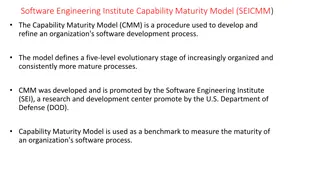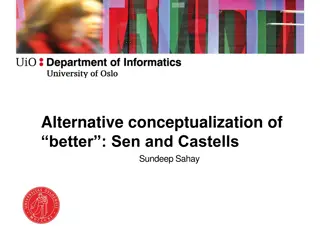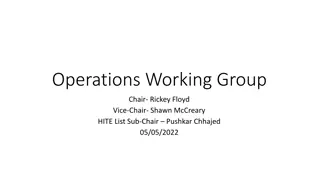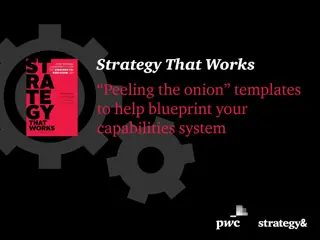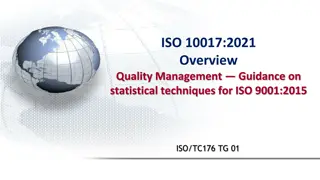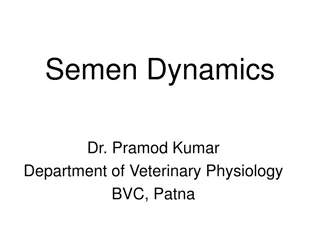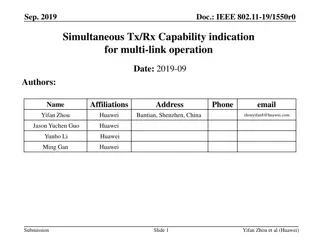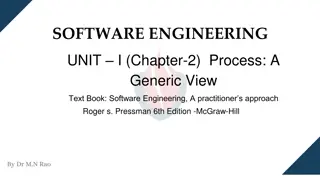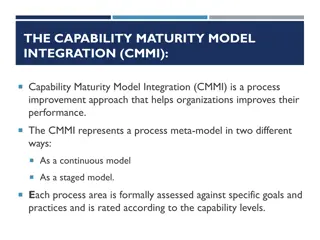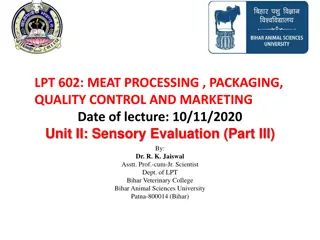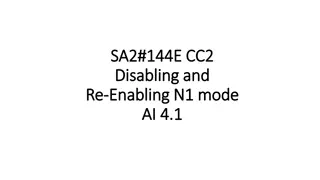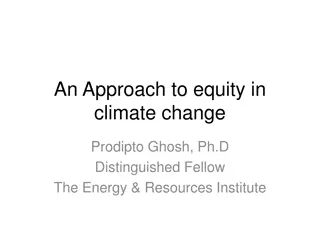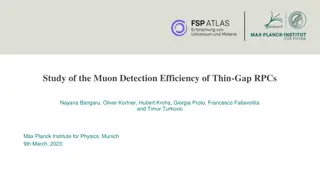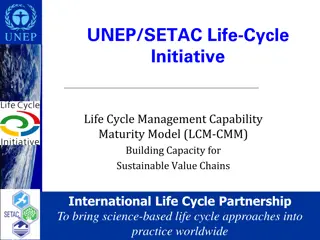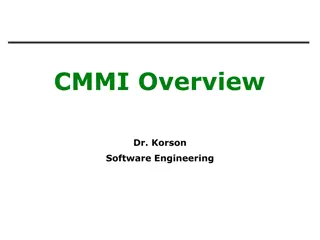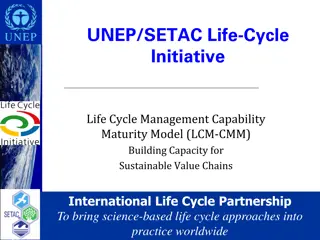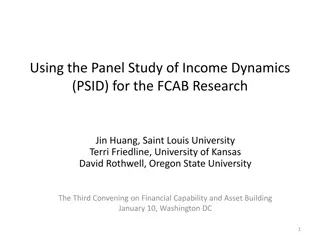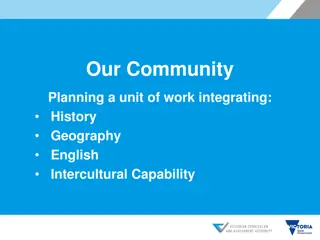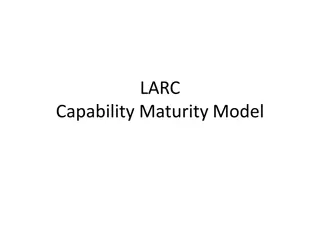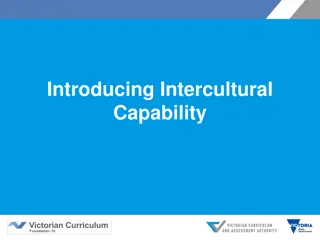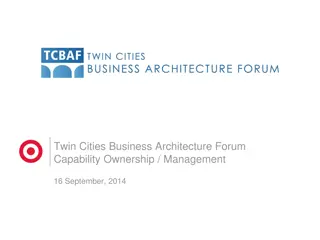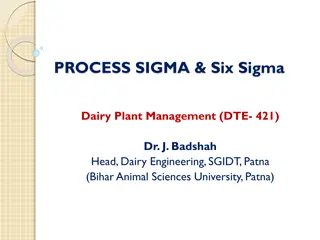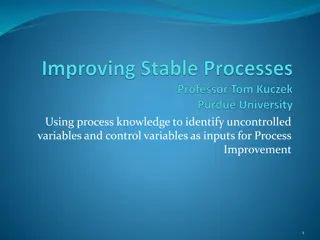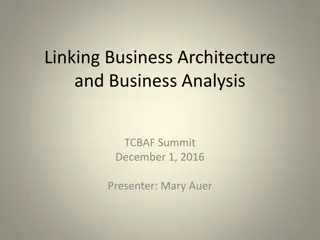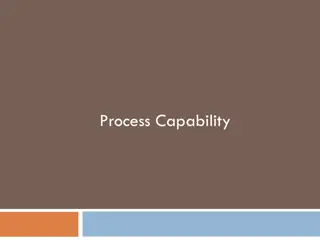NASA Navigation Sensor Technology Assessment Capability
The assessment of navigation sensor technologies for data-driven systems analysis by NASA in October 2023. Discover the motivation, method, survey, simulation model, and selected results of this capability.
0 views • 16 slides
Building Public Health Leadership in the Ambulance Sector
Christine Camacho discusses strategies for building public health leadership, capacity, and capability in the ambulance sector. Topics include addressing health inequalities, strategic leadership, accountability, and the importance of involving key stakeholders in the process.
0 views • 6 slides
Building a Script: Steps and Best Practices for Implementation
Explore the process of moving from an idea to implementing a script, including outlining best practices, considering factors before starting, and understanding the script lifecycle with a focus on design, writing, testing, and maintenance. Discover the importance of writing code for automation, cons
2 views • 14 slides
Developing Robotic Process Automation (RPA) Capability - NLIT Summit 2023 in Milwaukee, WI
This article discusses the initiative of developing Robotic Process Automation (RPA) capability in the national interest at the NLIT Summit 2023 in Milwaukee, WI. The focus is on maximizing efficiency, agility, and effectiveness by implementing RPA to automate digital tasks, reduce manual labor, and
2 views • 20 slides
Background to Capability Maturity Model Integration (CMMI)
The Capability Maturity Model Integration (CMMI) is a framework that helps organizations improve their processes and capabilities in developing and delivering high-quality products and services. The background to CMMI involves its evolution from earlier process improvement models and its widespread
0 views • 3 slides
Radiological Emergency Preparedness Program Assessment Guidance
This module covers the assessment policies and guidance for radiological emergency preparedness programs. It includes key concepts such as metrics for program evaluation, FEMA's assurance determination process, specific demonstration requirements, capability targets, and critical tasks. Participants
4 views • 22 slides
RAN4 Discussion on Enabling 3.45-3.55GHz in Band n77 for T-Mobile USA
In the electronic meeting of 3GPP TSG-RAN WG4, Issue 1.5-1 and Issue 1.5-2 were discussed regarding how to differentiate UEs supporting the new frequency range and modifying NOTE 12 in Table 5.2-1 in TS 38.101-1 to include the support of 3.45-3.55GHz in addition to 3.7-3.98GHz for Band n77 in the US
0 views • 6 slides
JAM Auto-Termination Capability in GPC Appointments
The JAM Auto-Termination capability in GPC appointments carries out routine, system-driven termination of appointments that are abandoned or associated with individuals in Archived status. This helps improve system-access internal control compliance, enhance security, and reduce fraud risk. Steps ca
0 views • 4 slides
Work Capability Assessment (WCA) Criteria Reforms May 2024
The Work Capability Assessment (WCA) determines if individuals claiming ESA and/or UC have limited capability for work (LCW) or work-related activity. Reforms aim to better support disabled individuals to engage with work. Consultation responses highlighted the need for changes in assessing disabili
0 views • 6 slides
NSW Public Sector Capability Framework Overview
Describes core knowledge, skills, and abilities required for all NSW public sector employees across different levels and occupational groups. The framework includes five progressive capability levels and provides a shared language for effective work performance. It integrates ethical values, non-spe
3 views • 10 slides
Understanding SEICMM - Software Engineering Institute Capability Maturity Model
The SEICMM, also known as the Capability Maturity Model (CMM), is a framework developed by the Software Engineering Institute (SEI) to enhance an organization's software development process. It consists of five maturity levels to assess and improve processes, from initial ad hoc activities to optimi
0 views • 6 slides
Rethinking Development: Perspectives on Human Capability and Well-being
Explore alternative conceptualizations of development beyond economic growth, focusing on human capability and freedom. Learn about Amartya Sen's capability approach and Manuel Castells' perspective on inclusion-exclusion in the Network Society. Discover the Human Development Index, Martha Nussbaum'
0 views • 24 slides
Personal IoT Network (PIN) Terminology Discussion for 3GPP TSG-SA WG1 Meeting
In this discussion, the concept of Personal IoT Network (PIN) and its elements are explored, including the roles of PIN Elements, Configuration PIN Capability, and Gateway Capability. The necessity of gateways to the 3GPP network, device examples, and the distinction of licensed spectrum are also ad
2 views • 10 slides
Updates and Discussions on ERCOT NPRRs and NOGRRs
ERCOT Operations Working Group (OWG) discussed various NPRRs (Nodal Protocol Revision Requests) like NPRR1084, NPRR1085, NPRR1100, NPRR1118, as well as NOGRR (Nodal Operating Guide Revision Requests) NOGRR215 and NOGRR226. The group reviewed comments, concerns, and recommendations related to resourc
5 views • 9 slides
Developing Strategic Capabilities: A Guide to Aligning Strategy with Execution
Explore the importance of aligning capability-building activities with strategic intent in companies. Learn the three-step process of creating a blueprint, building, refining, and scaling distinctive capabilities to ensure strategic success. Utilize templates to design a capabilities system that enh
1 views • 21 slides
Capability Maturity Model Cascade and Viral Load Testing Stages
This content discusses the Capability Maturity Model stages, focusing on process improvement and the stages of viral load testing demand creation. It outlines the evolution from initial to optimized stages and the development towards standardized processes in organizations. Additionally, it touches
3 views • 8 slides
USDA Robotic Process Automation (RPA) Assessment and Development Process
The USDA conducted a Robotic Process Automation (RPA) Process Assessment in July 2019, involving process robotics capabilities, development process under the Federated Model, and the lifecycle of a bot project. The RPA development process includes steps like requesting automation, process definition
1 views • 17 slides
ISO 10017:2021 Overview - Statistical Techniques for Quality Management
ISO 10017:2021 provides guidance on statistical techniques for quality management in alignment with ISO 9001:2015. It outlines various statistical techniques like descriptive statistics, hypothesis testing, process capability analysis, and more. The standard aims to help organizations monitor, contr
2 views • 8 slides
Understanding Semen Dynamics and Capacitation in Mammalian Spermatozoa
Semen dynamics play a crucial role in mammalian reproduction, with capacitation being a key process for sperm fertilization capability. Capacitation involves physiological changes in sperm, leading to the acrosome reaction, crucial for oocyte penetration. As sperm transit through the epididymis, the
5 views • 13 slides
IEEE 802.11-19/1550r0: Simultaneous Tx/Rx Capability Indication for Multi-Link Operation
This document discusses the simultaneous Tx/Rx capability indication for multi-link operation in IEEE 802.11-19/1550r0. It covers scenarios where link selection depends on link capabilities, actions needed based on Tx/Rx capabilities, and methods to indicate simultaneous operation. The importance of
4 views • 10 slides
Software Engineering: A Comprehensive Overview of Processes and Frameworks
Software engineering involves applying systematic and disciplined approaches to develop, operate, and maintain software efficiently. It utilizes layered technology and framework activities such as communication, planning, modeling, design, testing, and deployment. The field has evolved to encompass
0 views • 22 slides
Understanding the Capability Maturity Model Integration (CMMI) for Process Improvement
Capability Maturity Model Integration (CMMI) is a framework that aids organizations in enhancing performance by assessing process maturity levels. It offers continuous and staged models for process improvement, with each level representing specific goals and practices. By following CMMI, organizatio
0 views • 14 slides
Sensory Evaluation in Meat Processing: Panelist Selection, Training, and Sample Preparation
The lecture covers the sensory evaluation process in meat processing, focusing on the selection and training of panelists based on criteria like willingness, capability, and general health. Panelists are categorized as trained or semi-trained, with detailed guidelines for preparing and presenting me
0 views • 8 slides
Interworking Considerations for N1 Mode Capability in 5G Networks
The article discusses the implications of disabling and re-enabling N1 mode capability in UE operations when transitioning between 5G and 4G networks. It explores scenarios where session continuity may be affected and proposes solutions endorsed by industry stakeholders. Key points include the alloc
0 views • 5 slides
Approach to Equity in Climate Change by Prodipto Ghosh, Ph.D.
Prodipto Ghosh's presentation delves into the terrain of equity in climate change, emphasizing obligations of parties in mitigation, adaptation, and resource transfer. The proposed equity norms highlight cooperation, capability-based resource provisions, and ensuring low-capability individuals stay
0 views • 20 slides
Study of Muon Detection Efficiency in Thin-Gap RPCs
Conducted at the Max Planck Institute for Physics in Munich, this study focuses on the detection efficiency of thin-gap Resistive Plate Chambers. The research explores the construction, working principles, and experimental setup of RPCs, emphasizing the need for sensitive frontend electronics for hi
0 views • 14 slides
Sustainable Value Chains and Life Cycle Management Capability
The UNEP/SETAC Life-Cycle Initiative focuses on building capacity for sustainable value chains through the Life Cycle Management Capability Maturity Model (LCM-CMM). It emphasizes implementing science-based life cycle approaches globally by transitioning from events to management systems, conducting
1 views • 12 slides
Understanding CMMI and Process Maturity in Software Engineering
This overview explores the concept of Capability Maturity Model Integration (CMMI) in software engineering. It discusses the difference between mature and immature organizations, highlighting the characteristics of each. The focus is on the importance of processes, quality, and continuous improvemen
0 views • 21 slides
Life Cycle Management for Sustainable Value Chains: Building Capacity and Promoting Innovation
This content delves into the Life Cycle Management Capability Maturity Model (LCM-CMM) aimed at enhancing sustainable value chains globally. It emphasizes the importance of bringing science-based life cycle approaches into practical implementation to address global issues, international standards, c
1 views • 11 slides
Exploring John Keats's Negative Capability Theory in "Ode on a Grecian Urn
John Keats, known for his melancholic temperament, delved into the concept of Negative Capability in his poetry, particularly evident in "Ode on a Grecian Urn." This theory emphasizes the poet's ability to transcend rationality and immerse in intense emotions without the need for analysis or judgmen
0 views • 29 slides
Exploring Asset Accumulation and Financial Capability with PSID Data
Explore the Panel Study of Income Dynamics (PSID) data for research on financial capability and asset building. PSID is a longitudinal survey tracking households since 1968, covering various topics like wealth, savings, pensions, and more. The data allows for studying intergenerational dynamics, wea
0 views • 5 slides
Integrating History, Geography, English & Intercultural Capability in Community Planning
Exploring how to plan a unit of work integrating History, Geography, English, and Intercultural Capability based on the Victorian Curriculum. The unit, "Our Community," spans five weeks and focuses on continuity and change in the local community, significant places, people, and events, and interacti
0 views • 15 slides
Understanding the LARC Capability Maturity Model for Organizational Improvement
The LARC Capability Maturity Model (CMM) focuses on enhancing the viral load cascade, aiming to achieve better patient outcomes and improve institutional capabilities for viral load scale-up. Developed by Carnegie-Mellon University Software Engineering Institute in 1987, the CMM provides a structure
0 views • 14 slides
Enhancing Intercultural Capability in Victorian Curriculum
Victorian Curriculum F-10, released in 2015, emphasizes intercultural capability to develop students' awareness, respect, and skills in cultural diversity. It aims to foster understanding of different cultures, challenge stereotypes, and promote acceptance for a cohesive community. The curriculum st
0 views • 5 slides
Business Capability Ownership Roles and Responsibilities at Target
Explore the journey of developing business capabilities at Target, focusing on ownership roles such as Business Capability Owner, Leader/Manager, Steward, and Stakeholder. Learn how clarity, participation, and executive involvement are essential for successful capability framework creation and utili
0 views • 7 slides
Understanding Process Sigma and Six Sigma in Dairy Plant Management
Process Sigma and Six Sigma are key measures of process capability in Dairy Plant Management, indicating the level of defects and quality. CTQ features help in maintaining critical quality aspects to meet customer expectations. Learn how to calculate process Sigma and Sigma level in the context of a
0 views • 12 slides
Understanding Uncontrolled and Control Variables in Process Improvement
The process improvement involves identifying uncontrolled and control variables to enhance the process capability. Uncontrolled variables such as input rate and control variables like process settings play crucial roles. By understanding their impact on the process, common cause variation can be eff
0 views • 23 slides
The Connection Between Business Architecture and Business Analysis
Exploring the link between business architecture and business analysis, this presentation delves into the challenges faced by business architects in keeping enablers up to date, establishing a common language, identifying stakeholders, and ensuring traceability. The objective is to facilitate inform
0 views • 17 slides
Development of EIRENE-NGM for Neutral Gas Dynamics in Fusion Reactors
EIRENE-NGM project focuses on enhancing the neutral gas dynamics model for fusion reactor simulations, including efficient HPC utilization, physics basis refinement, database improvement, interface development, and predictive capability validation. Collaborators from various institutes aim to create
0 views • 17 slides
Understanding Process Capability in Quality Management
Process capability is a crucial concept in quality management that evaluates the ability of a process to meet design specifications. It focuses on the relationship between process variation and desired standards, ensuring that products consistently match set criteria. Learn about Cp, Cpk, and other
0 views • 11 slides

